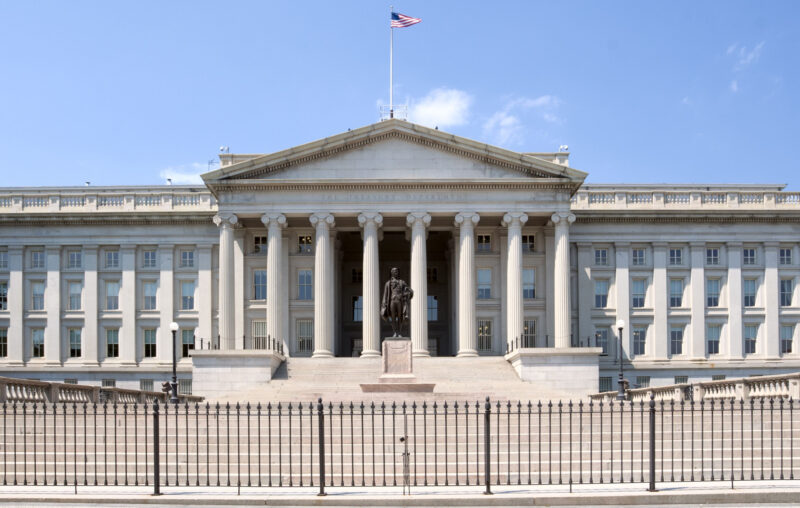
We often hear that if the US government defaults on its debt, that will be unprecedented. But one Treasury Secretary in our history actually structured a default on federal debt. Who was it? Hint: there’s a popular musical on Broadway by the same name. That’s right, it was Alexander Hamilton.
Hamilton became Treasury Secretary in 1789. He faced a tough situation: loans, both foreign and domestic, including state debts, had financed nearly one-third of the cost of the Revolutionary War. Although the interest owed on Dutch loans was still being paid in specie (gold and silver), the Continental Congress since May 1782 had resorted to paying interest on its domestic loans mainly with what were called “indents,” which were essentially paper IOUs. After 1789, even with the new government’s taxing powers, there was no way the entire debt could be paid off directly and completely. Instead, creditors were offered new securities that would pay interest in specie. Hamilton’s report to Congress recommended that foreign debt of $11.7 million be fully funded, and Congress did so by authorizing new Dutch loans. But for the domestic debt of $65.4 million (including arrears on interest and the assumed state war debts), Hamilton concluded that the initially promised interest rate of 6 percent was more than the government could comfortably afford. He therefore offered Congress several different schemes to reduce that rate.
Congress ultimately adopted a plan to offer two-thirds of the principal owed to holders of the domestic debt securities that paid 6-percent annual interest. The securities had no fixed maturity, effectively making them like perpetual British consols. These 6 percent consols had an embedded call option, allowing the Treasury to redeem them at no faster than 8 percent of their initial face value per year, counting both interest and principal. If the Treasury repeatedly exercised the call option over time, it made the consols similar to today’s fixed-rate mortgages (minus the mortgage-holders ability to pay off their entire debt early). For the other third owed, creditors received what were called deferred consols, paying the same 6 percent interest rate but beginning only in 1801, ten years later. This was a result of Hamilton’s desire to reduce the effective interest cost below 6 percent to an overall average slightly above 4 percent. The indents for arrears of interest were treated separately, being redeemed with consols paying only 3 percent annual interest.
The bottom line is that the funding of the domestic debt involved a haircut that, in all but name, was a partial default. Using a discount rate of 6 percent, we calculate that someone who exchanged $100 of the Continental Congress’s wartime debt, with one-third of that funded with deferred 6 percent consols received assets whose present value was only $82. At the same discount rate, the present value of $100 worth of 3 percent consols was $50. Moreover, Hamilton and Congress never even considered the idea of paying additional interest on the arrears of interest. And the assumed state debts had even a more severe haircut on principal and interest; the present value for $100 of that debt had been reduced to $59. Some holders of the Revolutionary War debt, particularly in New England, were outraged at the loss of a full 6 percent interest on all the new securities. Of course, prior to the refunding, the wartime debt securities had been trading well below their face value.
You might think that this story is irrelevant to the current situation because the 14th Amendment to the US Constitution was not ratified until July 9, 1868. Section 4 of that Amendment reads, in part: “The validity of the public debt of the United States, authorized by law, including debts incurred for payment of pensions and bounties for services in suppressing insurrection or rebellion, shall not be questioned.” But Section VI of the Constitution had already covered the general issue of federal debt. It reads, in part, “All Debts contracted and Engagements entered into, before the Adoption of this Constitution, shall be as valid against the United States under this Constitution, as under the Confederation.” So Hamilton’s haircuts seem completely relevant to today’s controversy.
Whatever you think of the wisdom of Hamilton’s moves, our point is simple and stark: The US government has defaulted in the past.
* This article was originally published here
PUBLISH WITH US!
The Washington Gazette works at our discretion with businesses, non-profits, and other organizations. We do not work with socialists, crony capitalists, or disinformation groups. Click the green button below to view our services!
HELP STOP THE SPREAD OF FAKE NEWS!
SHARE our articles and like our Facebook page and follow us on Twitter!




0 Comments